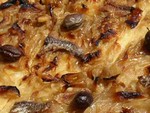The Classic
Pissaladière
PISSALADIERA
*My Market*
– 500 grams of flour
– a packet of baking powder
– 2 deciliters of olive oil
– 2 kilograms of onion
– 100 grams of Nice olives
– 100 grams of salted anchovies
– bay leaf, thyme, and rosemary
– salt, pepper
Preparation: 30 minutes
Dough resting: 1 hour
Total cooking time: 45 minutes
*I Cook*
I peel the onions, rinse them, and slice them into thin rings. I sauté them in a pan with olive oil, bay leaf, thyme, and rosemary.
I salt and pepper them, cover, and let them cook over low heat for half an hour, stirring occasionally to prevent burning. Meanwhile, I prepare the dough.
In a large bowl, I pour the flour, baking powder, water, and a little salt. I add 1 to 2 dl of olive oil and mix everything together. I cover with a cloth and let it rest for an hour. I grease a tart pan or a baking sheet.
I roll out the dough to the size of the dish (about 2 to 3 millimeters thick). I pre-bake it for 5 to 10 minutes.
After removing the herbs, I pour the onions over the dough and spread them out. I decorate it with olives and anchovy fillets that I have previously rinsed well.
I bake it in a preheated oven for 20 to 30 minutes at 250°C. I pepper before serving.
Niçois aperitif (photo Henri Faraud)
*Our Tips*
Traditionally, the dough was a bread dough made without oil, only with flour, sourdough (baker’s yeast), water, and salt. It was made on a wooden board. The flour was piled in a heap, the yeast and salt were mixed well. A hollow was made in the middle, and water was poured in gradually, mixing slowly in a circular motion with a fork. A ball of dough was obtained, which was left to rest in a bowl covered with a cloth.
At the beginning of the century, pissaladière was made from pissala, hence its name. Back then, pissala was prepared from the entrails of anchovies. Today, you might prefer another preparation: in a glass or earthenware pot, place a layer of coarse salt, a layer of aromatic herbs, preferably rosemary, thyme, and bay leaf, crushed (or blended), then a layer of fish, repeating until the pot is nearly full, similar to how you would make salted anchovies. A final layer of salt and herbs is added to finish. A large, flat stone is placed on top to press it down, and it is kept in a cool place for a month. After a month, everything is crushed in a pestle (or blended if one is not afraid of breaking tradition) and put back in the pot under a layer of salt. Your pissala is ready. For the fish, prefer small ones: fry, “gobis,” small anchovies, or possibly “poutine” when it is affordable. The old Niçois would add the roe of small crustaceans, sea urchin glands, and even the guts of gutted fish. The pissala can be spread on the dough before placing the onions.
The New
Anchoutinada de Giordan
*My Market*
– 500 grams of fresh anchovies
– 7 eggs
– 50 grams of parsley
– 2 cloves of garlic
– 200 grams of salad (preferably mesclun)
– olive oil
– salt, pepper
Preparation: 15 minutes
Cooking: 10 minutes
*I Cook*
I start by gutting and washing the anchovies in water.
I separate the fillets from the bones, then let them drain.
I grind them in a mixer with parsley (not leaving too much stem), garlic, salt, and pepper.
I beat the eggs in a bowl and incorporate the anchovies.
Now, I just need to cook it in hot olive oil.
I serve the Anchoutinada de Giordan either cold or warm on a bed of seasoned salad (preferably mesclun, dandelions, or oak leaves). If necessary, I can present a little frisée.
*Our Tips*
This is a dish we recommend because it is truly excellent, on par with the famous “poutine” omelet. Many of our “guests” have often confused it or found it better. As for the quality-price ratio, let’s not even mention it!
In the same style, you can use fresh sardines or scorpion fish.
Try it once with red mullet: you will need to spend a bit more time filleting the fish and removing the bones.


